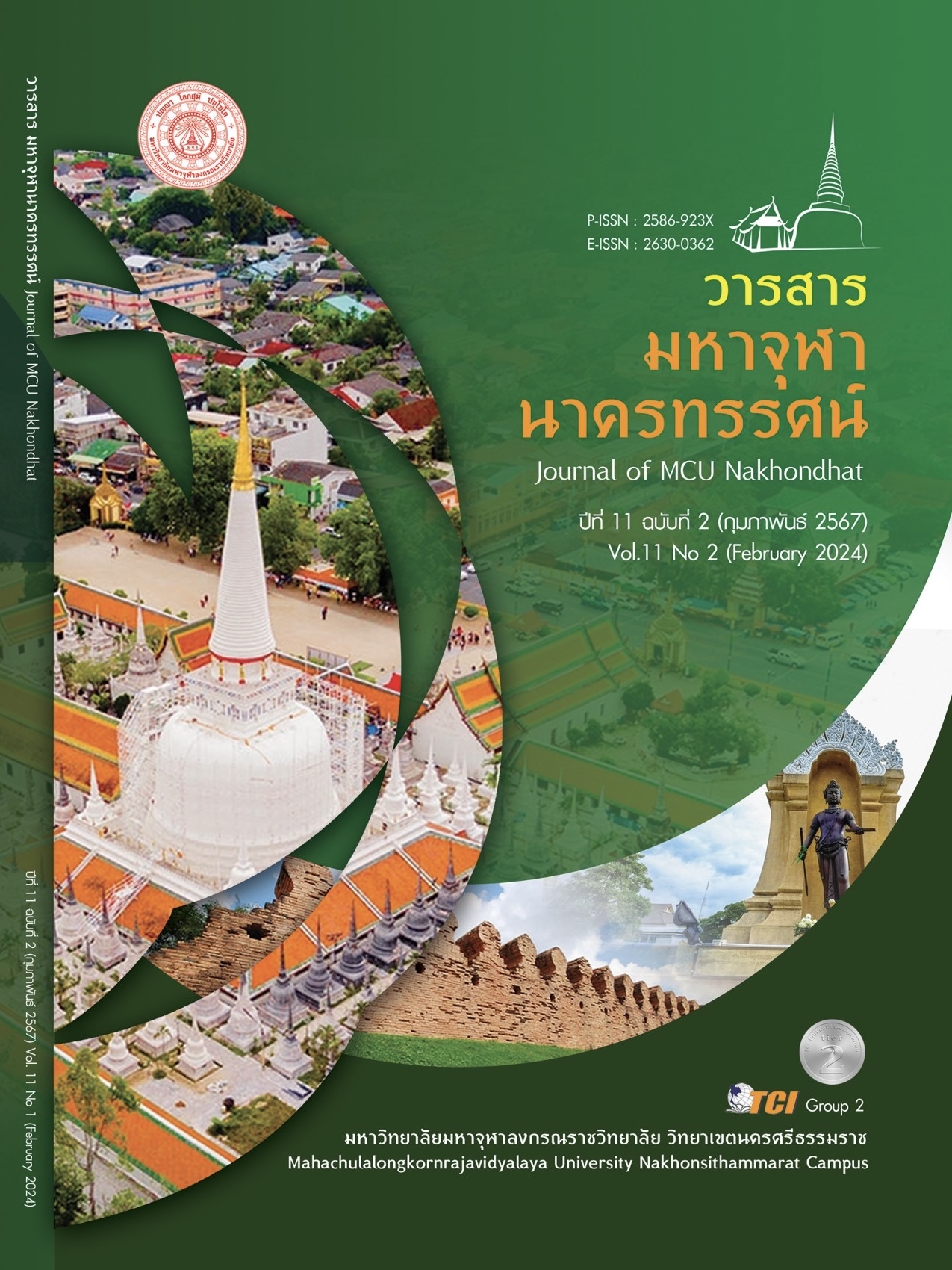SELF - CARE BEHAVIORS AND BLOOD PRESSURE CONTROLLING OF HYPERTENSION PATIENTS, KOH SAMUI HOSPITAL, SURAT THANI PROVINCE
Main Article Content
Abstract
This research aimed to study the self - care behaviors, blood pressure controlling ability, and the factors related to self - care behaviors of hypertension patients by using cross-sectional analytical research design. The sample group was 380 Thai pepole who has been diagnosed by a doctor with essential hypertension, who received treatment at the outpatient department, Koh Samui Hospital, they were able to help themselves and willing to cooperate in the study, selected by systematic random sampling. Research instruments were questionnaire and medical record form. Data were collected between 12 December 2023 and 15 January 2024 and analyzed by descriptive statistics namely number, percentage, mean, standard deviation) and Pearson’s product moment correlation. The results found that 82.1% of hypertension patients had moderate self - care behaviors, followed by good and low level at 10.8% and 7.1%, respectively. They could control blood pressure at 21.3%. In this regard, hypertensive information receiving (r = 0.284) and social support receiving (r = 0.367) were positive significantly related with self - care behaviors (p-value < 0.001) at low and medium levels, respectively. For age, duration of illness with hypertension and knowledge of hypertension and hypertensive information receiving were not related to self - care behavior. According to the results, should be promoted hypertension patients to modify the more appropriate self - care behavior, received information about high blood pressure and supported families to help care for more patients.
Article Details

This work is licensed under a Creative Commons Attribution-NonCommercial-NoDerivatives 4.0 International License.
References
ฐิติรัตน์ ศิริพิบูลย์. (2564). พฤติกรรมการดูแลตนเอง และความสามารถในการควบคุมความดันโลหิต ของผู้ป่วยโรคความดันโลหิตสูง โรงพยาบาลส่งเสริมสุขภาพตำบล จังหวัดสมุทรสาคร. สมุทรสาคร: สำนักงานสาธารณสุขจังหวัดสมุทรสาคร.
ธเรศ กรัษนัยรวิวงค์. (2566). กรมควบคุมโรค แนะประชาชนวัดความดันโลหิตอย่างสม่ำเสมอ “รู้เลข รู้เสี่ยง เลี่ยงโรคไม่ติดต่อ. เรียกใช้เมื่อ 22 ตุลาคม 2566 จาก https://www.prd.go.th/th/content/category/detail/id/9/iid/182186
ประพนธ์ ดิษฐ์รุ่งโรจน์. (2560). ปรับพฤติกรรม ลดความดันโลหิต. เรียกใช้เมื่อ 15 พฤศจิกายน 2565 จาก https://www.samitivejhospitals.com/th/article/detail
พิชิตศักดิ์ จำปาเงิน. (2565). พฤติกรรมการดูแลตนเอง และความสามารถในการควบคุมความดันโลหิตของผู้ป่วยโรคความดันโลหิตสูง ในพื้นที่รับผิดชอบโรงพยาบาลส่งเสริมสุขภาพตำบลบ้านโค้งบ่อแร่. สุพรรณบุรี: โรงพยาบาลส่งเสริมสุขภาพตำบลบ้านโค้งบ่อแร่.
ภฤดา แสงสินศร. (2564). ปัจจัยที่มีความสัมพันธ์ กับพฤติกรรมสุขภาพ ของประชาชนที่มีภาวะเสี่ยงต่อโรคเบาหวานและความดันโลหิตสูง ในเขตจังหวัดพิจิตร. วารสารวิจัยและวิชาการสาธารณสุขจังหวัดพิจิตร, 2(2), 43-54.
รักชนก จันทร์เพ็ญ. (2564). ประสิทธิผลของโปรแกรมส่งเสริมสุขภาพผู้ป่วยโรคความดันโลหิตสูง ในคลินิกความดันโลหิตสูง โรงพยาบาลดำเนินสะดวก จังหวัดราชบุรี. วารสารวิจัยเพื่อการส่งเสริมสุขภาพและคุณภาพชีวิต, 1(2), 20-30.
โรงพยาบาลเกาะสมุย. (2566). สถิติผู้ป่วยโรคความดันโลหิตสูง โรงพยาบาลเกาะสมุย. สุราษฎร์ธานี: โรงพยาบาลเกาะสมุย.
ศิริรักษ์ เกียรติเฉลิมพร. (2566). พฤติกรรมการดูแลตนเอง และความสามารถในการควบคุมความดันโลหิตของผู้ป่วยโรคความดันโลหิตสูง โรงพยาบาลส่งเสริมสุขภาพตำบล จังหวัดกระบี่. กระบี่: สำนักงานสาธารณสุขจังหวัดกระบี่.
ศูนย์การศึกษาต่อเนื่องทางเภสัชศาสตร์. (2563). การประชุมวิชาการชมรมร้านขายยาแห่งประเทศไทย ครั้งที่ 1 ประจำปี 2563 เรื่อง “ความดันโลหิตสูง: สิ่งที่น่ารู้และต้องรู้”. เรียกใช้เมื่อ 22 สิงหาคม 2566 จาก https://ccpe.pharmacycouncil.org/index.php?option=seminar_detail&subpage=seminar_detail&id=3115
สถาบันวิจัยและประเมินเทคโนโลยีทางการแพทย์ กรมการแพทย์ กระทรวงสาธารณสุข. (2560). สถานการณ์โรคเบาหวาน/ความดันโลหิตสูงและภาวะแทรกซ้อนในประเทศไทย. เรียกใช้เมื่อ 25 กันยายน 2566 จาก http:/www.dms.moph.go.th/imrta/images/data/doc_dm_ht.pdf
สมาคมความดันโลหิตสูงแห่งประเทศไทย. (2563). การประชุมวิชาการประจำปีครั้งที่ 18 สมาคมความดันโลหิตสูงแห่งประเทศไทย. เรียกใช้เมื่อ 25 กันยายน 2566 จาก http://thaihypertension.org/files/452_1.Thai%20Hypertension%20Conference%202020.pdf
เสงี่ยม จิ๋วประดิษฐ์กุล. (2560). พฤติกรรมการดูแลตนเอง และความสามารถในการควบคุมความดันโลหิตของผู้ป่วยโรคความดันโลหิตสูงชนิดไม่ทราบสาเหตุ ศูนย์สุขภาพชุมชนเมืองโพธาวาส. วารสารวิจัยและนวัตกรรมทางสุขภาพ, 3(1), 15-30.
เสาวนีย์ ลาเสือ และคณะ. (2561). ปัจจัยที่มีความสัมพันธ์ต่อพฤติกรรมการดูแลตนเองของผู้ป่วยโรคความดันโลหิตสูงที่มารับบริการ ณ โรงพยาบาลส่งเสริมสุขภาพตําบลบ้านตันหยงเปาว์ ตําบลท่ากําชํา อําเภอหนองจิก จังหวัดปัตตานี. วารสารวิชาการเฉลิมกาญจนา, 5(1): 111-120.
อัมภากร หาญณรงค์. (2560). ปัจจัยที่มีอิทธิพลต่อพฤติกรรมการบริโภคอาหารของผู้ป่วยโรคความดันโลหิตสูง. วารสารคณะพยาบาลศาสตร์ มหาวิทยาลัยบูรพา, 25(3), 52-65.
Adam Wondmieneh, et al. (2021). Self-Care Practice and Associated Factors among Hypertensive Patients in Ethiopia: A Systematic Review and MetaAnalysis. International Journal of Hypertension, 2021(11), 1-16.
American Heart Association. (2017). Hypertension: Ten ways to control your blood pressure. Retrieved March 8, 2023, from http://www.americanheart.org/presenten
Bloom, B. S. (1999). Taxonomy of education objective handbook I: Cognitive domain. New York: David Mc Kay.
Green, L. W., & Kreuter, M. W. (2005). Health program planning an educational and ecological approach. New York: Quebecor World Fairfield.
Moh Rozani. (2019). Self-care and Related Factors in Hypertensive Patients: a Literature Review. Dinamika Kesehatan Jurnal, 10(1), 266-276.
Pender P. J. (1996). Health Promotion in nursing practice. 3d ed. Toronto: Prentice Hall. Canada.
Weber, et al.,. (2022). Clinical practice guidelines for the management of hypertension in the community: A statement by the American Society of Hypertension and the International Society of Hypertension. Retrieved December 2, 2023, from http://www.ashus.org/documents/ash_ish-guidelines_2013.pdf


